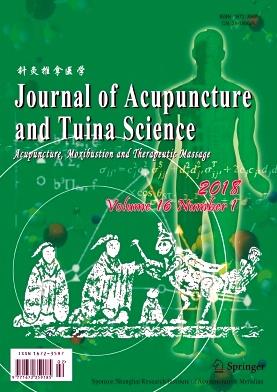艾灸对肠易激综合征小鼠行为学及色氨酸代谢相关产物的影响
IF 0.5
4区 医学
Q4 INTEGRATIVE & COMPLEMENTARY MEDICINE
引用次数: 0
摘要
摘要目的观察艾灸对肠易激综合征(IBS)小鼠结肠色氨酸(Trp)代谢行为及相关产物的影响,探讨艾灸治疗IBS的机制。方法将24只小鼠随机分为正常组、模型组、艾灸组和益生菌组,每组6只。采用2,4,6-三硝基苯磺酸(TNBS)溶液灌肠建立IBS内脏痛模型。艾灸组小鼠给予双侧足三里(ST36)轻度艾灸,益生菌组小鼠给予双歧杆菌等益生菌灌胃治疗。治疗后进行腹部退缩反射(AWR)试验、升高正迷宫(EPM)试验和强迫游泳试验(FST)。采用免疫荧光法检测结肠组织中5-羟色胺(5-HT)和色氨酸羟化酶1 (TPH1)的表达水平,采用酶联免疫吸附法检测结肠组织中色氨酸、犬尿氨酸(Kyn)和吲哚-2,3-加氧酶(IDO)的表达水平。结果与正常组比较,模型组不同压力值下AWR评分均显著升高(P <0.01), EPM试验张开臂停留时间和张开臂进入时间均显著减少(P <0.01, P <0.05), FST静止时间均显著增加(P <0.01),结肠Trp、TPH1、IDO、5-HT、Kyn表达水平均显著升高(P <0.01)。与模型组比较,艾灸组和益生菌组大鼠AWR评分均有不同程度降低(P <0.05或P <0.01), EPM试验张开臂次数增加(P <0.05), FST静止时间减少(P <0.05),结肠中Trp、TPH1、IDO、5-HT表达水平降低(P <0.01或P <0.05);艾灸组大鼠张开臂停留时间显著增加(P <0.01),益生菌组大鼠结肠Kyn表达水平显著降低(P <0.01)。结论艾灸足三里(ST36)可改善IBS小鼠内脏疼痛和疼痛情绪,下调结肠TPH1、IDO、Trp、5-HT、Kyn表达水平。本文章由计算机程序翻译,如有差异,请以英文原文为准。
艾灸对肠易激综合征小鼠行为学及色氨酸代谢相关产物的影响
Abstract Objective To observe the effect of moxibustion on behaviors and related products of tryptophan (Trp) metabolism in the colon of mice with irritable bowel syndrome (IBS), and to explore the mechanism of moxibustion in the IBS treatment. Methods Twenty-four mice were randomly divided into a normal group, a model group, a moxibustion group, and a probiotic group, with 6 mice in each group. The visceral pain model of IBS was established by enema with 2,4,6-trinitrobenzene sulfonic acid (TNBS) solution. Mice in the moxibustion group were treated with mild moxibustion at bilateral Zusanli (ST36), and those in the probiotic group were treated with probiotics such as Bifidobacterium by gavage. Abdominal withdrawal reflex (AWR) test, elevated plus-maze (EPM) test, and forced swimming test (FST) were performed after treatment. The expression levels of 5-hydroxytryptamine (5-HT) and tryptophan hydroxylase 1 (TPH1) in the colon were detected by immunofluorescence, and the expression levels of Trp, kynurenine (Kyn), and indole-2,3-oxygenase (IDO) in the colon were detected by enzyme-linked immunosorbent assay. Results Compared with the normal group, the AWR scores were increased significantly in the model group under different pressure values ( P <0.01), the open-arm staying time and open-arm entries in the EPM test were decreased significantly ( P <0.01, P <0.05), the motionless time in the FST was increased significantly ( P <0.01), and the expression levels of colonic Trp, TPH1, IDO, 5-HT, and Kyn were increased significantly ( P <0.01) in the models. Compared with the model group, the AWR scores were differently decreased ( P <0.05 or P <0.01), the open-arm entries in the EPM test were increased ( P <0.05), the motionless times in the FST were decreased ( P <0.05), and the colonic expression levels of Trp, TPH1, IDO, and 5-HT were decreased ( P <0.01 or P <0.05) in the moxibustion and probiotic groups; the open-arm staying time was significantly increased in the moxibustion group ( P <0.01), and the colonic expression level of Kyn was significantly decreased in the probiotic group ( P <0.01). Conclusion Moxibustion at Zusanli (ST36) improves visceral pain and pain mood and down-regulates the expression levels of colonic TPH1, IDO, Trp, 5-HT, and Kyn in IBS mice.
求助全文
通过发布文献求助,成功后即可免费获取论文全文。
去求助
来源期刊

Journal of Acupuncture and Tuina Science
INTEGRATIVE & COMPLEMENTARY MEDICINE-
CiteScore
0.60
自引率
40.00%
发文量
55
期刊介绍:
Journal of Acupuncture and Tuina Science (ISSN 1672-3597, CN 31-1908/R) is a journal with an international scope, focusing on the popularization of traditional Chinese medicine and acupuncture- moxibustion culture, the promotion of international exchanges and the prosperity of clinical Chinese medicine and acupuncture-moxibustion. Journal of Acupuncture and Tuina Science mainly involves clinical practice and emphasizes the presentation of the detailed methods of observing and treating clinical common diseases on which acupuncture-moxibustion has a good effect. The articles are characterized by practicality, briefness and reproducibility. The main contents include the experiences of senior TCM doctors, forum on special diseases, clinical reports, brief reports, education series, terminology and brief introduction to new books. Communications regarding Academy activities are also appropriate.
 求助内容:
求助内容: 应助结果提醒方式:
应助结果提醒方式:


